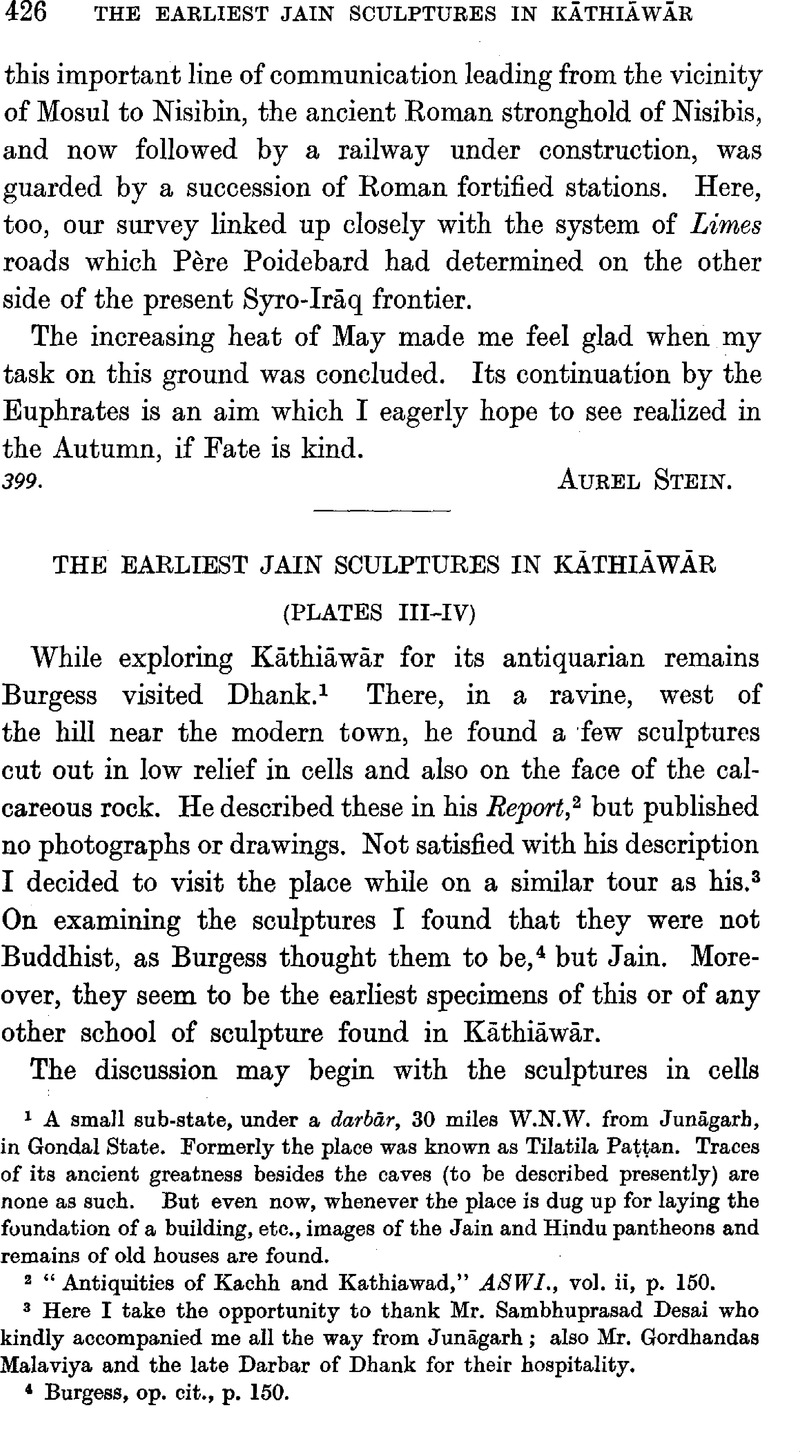No CrossRef data available.
Article contents
The Earliest Jain Sculptures in Kāthiāwār
Published online by Cambridge University Press: 15 March 2011
Abstract

- Type
- Miscellaneous Communications
- Information
- Copyright
- Copyright © The Royal Asiatic Society 1938
References
page 426 note 1 A small sub-state, under a darbār, 30 miles W.N.W. from Junāgarh, in Gondal State. Formerly the place was known as Tilatila Paṭṭan. Traces of its ancient greatness besides the eaves (to be described presently) are none as such. But even now, whenever the place is dug up for laying the foundation of a building, etc., images of the Jain and Hindu pantheons and remains of old houses are found.
page 426 note 2 “Antiquities of Kachh and Kathiawad,” ASWI., vol. ii, p. 150.
page 426 note 3 Here I take the opportunity to thank Mr. Sambhuprasad Desai who kindly accompanied me all the way from Junāgarh; also Mr. Gordhandas Malaviya and the late Darbar of Dhank for their hospitality.
page 426 note 4 Burgess, op. cit., p. 150.
page 427 note 1 The photograph is not clear enough for reproduction.
page 427 note 2 It is difficult to be definite on this point. Some fifty years ago Burgess saw traces of drapery, etc., while at present there are none. On the analogy of the wall-figures on the adjoining hill I am inclined to think that the figures were originally nude.
page 427 note 3 Two lions on either side of a bull are found on an early image (circa a.d. 150) of Ādinātha from the Jain stūpa at Mathurā. See Smith, Vincent, “The Jain Stupa and other Antiquities of Mathura,” Arch. Survey of India, vol. xx, pl. xcviiiGoogle Scholar. If there were only one lion, the figure should have been identified with that of Māhāvīra.
page 427 note 4 In early Jain figures, the hair is worn in rolls or curls, but later it develops into a conventional style known as uṣṇīṣa.
page 427 note 5 See Pls. III and IV.
page 427 note 6 See Pl. III.
page 428 note 1 Smith, op. cit., pl. xcviii. Note that the sitting posture of the goddess as well as of the child and the lion are identical.
page 428 note 2 A similar figure is found at Elura, , ASWI., vol. v, pl. xl, fig. 2Google Scholar, and a Ankai caves. Ibid., p. 58. For paintings see Nawab, Jain Gitrakalpadruma, fig. 45.
page 428 note 3 See fig. Pl. III.
page 428 note 1 At Bharhut, the folds are similar but are two only (Cunningham, The Stupa of Bharhut, pl. xxviii). At Amarāvatī (Fergusson, Tree and Serpent Worship, pl. lxxvi) they are different. At Bādāmi (ASWI., “1874 Report, Belgam and Kaladgi,” pl. xxxvi, fig. 3) the similarity is close, but the representation of the serpent is different. At Elura (Fergusson, Cave Temples of India, pl. lxxxvi) Pārśvanātha stands on a two-decked ornamental stool, but the serpent is very dissimilar from that at Dhank. It is interesting to note in this connection that a serpent with similar folds but without the hood is noticed on Roman coins of Tralles (Fergusson, op. cit., p. 19, No. 2), and on an image from Gwalior in the Indian Museum, South Kensington, London. Also, cf. Takshaka, from Takshakeśvara, Indore State, where the folds are similar. ASIWC., 1920, pi. xiii; also p. 80.
page 428 note 5 See Pl. III.
page 428 note 6 See Pl. IV.
page 429 note 1 And even the wheel was worshipped by the Jains as is attested by numerous Jain sculptures from Mathura. See Vogel, , Catalogue, Mathura, p. 70Google Scholar.
page 429 note 2 Fergusson, , Cave Temples of India, p. 507Google Scholar.
page 429 note 3 See Pl. IV.
page 429 note 4 See Pl. IV.
page 429 note 5 These have not come out in the photograph.
page 429 note 6 Though Burgess finds great likeness in these figures with those of the Jinas at Bādāmi, Aihoḷe, and Ajanta, he calls them Buddhas! AKK., p. 151.
page 430 note 1 Cf. Burgess, , Digambara Jain Iconography, p. 5Google Scholar. “All the Yakshas and Yakshiṇīs have similar high tapering head-dresses.”
page 430 note 2 Ibid., pp. 3–4.
page 430 note 3 “Andhau Inscriptions of the time of Rudradāman, No. c,” Ep. Ind., vol. xvi, p. 25; and “Stone Inscription of the grandson of Jayadāman, found from Bāwa Pyāra Caves, Junāgarh,” ibid., p. 239.




